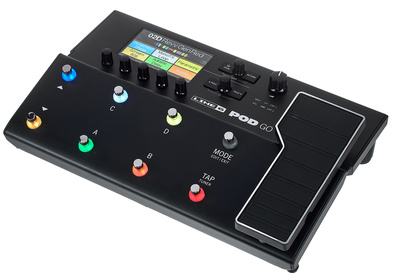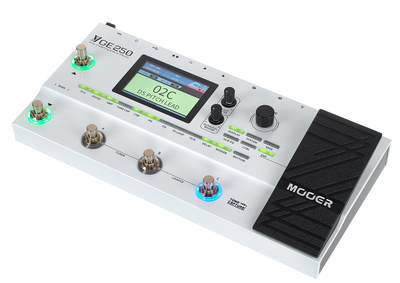Metallica Sound: Effects and Equipment
Which effects pedals are necessary for achieving the classic Metallica sound?
With over 110 million albums sold, Metallica is considered one of the most successful metal bands of all time. They are considered one of the “big four” of '80s thrash metal. Their sound is defined by the interplay between guitarists James Hetfield and Kirk Hammett. It's no wonder that many guitarists emulate their sound. In this article, we'll show you how to get closer to the Metallica sound with affordable effects devices.
About the Band
Metallica was founded in Los Angeles in 1981 by guitarist and vocalist James Hetfield and drummer Lars Ulrich. Ulrich quickly adopted the name "Metallica" from a list of names for a metal fanzine that a friend had asked him to review. Shortly after recording their first song, Hetfield and Ulrich found a talented lead guitarist, Dave Mustaine, and accepted him as a permanent member. In 1982, a year later, the band replaced bassist Ron McGovney with Cliff Burton. Burton remained with the band until his tragic death in an accident in 1986. After he joined, the band moved to San Francisco at Burton's request.

Metallica parted ways with their lead guitarist, Dave Mustaine, at the end of 1982 due to disagreements. Mustaine went on to achieve great success with his own band, Megadeth. He was replaced by Kirk Hammett, who remains an indispensable member of Metallica to this day. Together with James Hetfield, Hammett is responsible for the band's signature guitar sound.
In the summer of 1983, the band released their debut studio album, Kill 'Em All, which initially had mediocre sales. Their second studio album, Ride the Lightning, was significantly more successful, selling nearly 100,000 copies. Metallica finally had their big breakthrough in 1986 with their third studio album, Master of Puppets, which went gold within a month. Just a few months later, Cliff Burton was killed in a tour bus accident. The remaining band members decided to continue and eventually brought Jason Newsted into the band as the new bassist.
This was followed by the highly successful albums "...And Justice for All" and "Metallica," also known as the "Black Album." In 1996 and 1997, Metallica released Load and ReLoad. On these albums, the band developed a new style influenced by blues and country, which was often criticized by fans. In 1999, "Nothing Else Matters" was finally released as a single — a song that just about everyone has probably heard on the radio at some point.
In January 2001, Jason Newsted left Metallica because he felt James Hetfield had treated him unfairly. Hetfield had sharply criticized Newsted for his musical projects outside of Metallica. Legendary producer Bob Rock played bass on the new album St. Anger. With St. Anger, Metallica returned to a harder metal sound, which some fans criticized. Nevertheless, the album was a success, reaching number one on the charts in more than 30 countries. In 2003, the band found a new bassist, Robert Trujillo, who had previously played with Ozzy Osbourne and Suicidal Tendencies. This was followed in 2008 by the ninth studio album, Death Magnetic, and most recently, in 2018, by Hardwired... to Self-Destruct.
The sound and equipment of Metallica's guitarists
When discussing Metallica's sound, it's important to be transparent and share the following: As an amateur guitarist, you will only be able to approximate their original sound. This is because the band's guitarists use very expensive equipment. To achieve the original Metallica sound, you would need to invest at least $5,000 in equipment.
But don't worry; in this article, we'll show you how to achieve an affordable version of the Metallica sound for significantly less. First, let's take a look at the equipment the band uses and the available signature devices.
James Hetfield
The use of active humbucker pickups in his guitar is undoubtedly one of the most important elements of his sound. He almost exclusively uses ESP and Gibson guitars. He prefers EMG pickups, which are available as a matching Hetfield Signature set* for around $200. While not absolutely necessary, a humbucker pickup is recommended as it can be difficult to achieve a satisfactory sound with a single-coil pickup. If you're planning to buy a new guitar, you might want to check out the Hetfield signature models: the ESP LTD Vulture*, the ESP LTD Snakebyte*, and the ESP LTD Iron Cross*.
As for amplifiers, James Hetfield primarily used Marshall's JCM 800* in Metallica's early days, then Mesa/Boogie Mk IIc, and finally Rectifier models. For more recent albums, he relied on Mesa TriAxis and Diezel VH4, the latter of which he used extensively on St. Anger. James mainly relies on Roland's JC-120 for undistorted sound.
You'll probably be particularly interested in the pedals used by James Hetfield. When it comes to distortion and overdrive, he has been a big fan of the Ibanez TS808 Tube Screamer* since using the ProCo Rat* on Kill 'Em All. He used it from Ride the Lightning onwards to enhance the sound of Marshall amplifiers, which he considered too tame. Later, he switched to the G-Major 2, a profile multi-effects rack unit from TC Electronic, for live performances. He has also been spotted using a Klon Centaur overdrive pedal. For phaser sounds, he relied on the MXR Phase 100* pedal, among others. For wah sounds, he used the Cry Baby from Dunlop*. Since the early 2000s, Hetfield has reportedly used the Line 6 DL4* (the link leads to its successor, the Line 6 DL4 MK2) for delays.
Kirk Hammett
When it comes to sound, Kirk Hammett and James Hetfield agree on many things. Like Hetfield, Hammett has long been a fan of Mesa/Boogie amplifiers, such as the Dual Rectifier and Rectifier 4x12 Standard Slant cabinets. However, in recent years, Hammett has switched to Randall amplifiers and released his own signature series. Regarding guitars, Hammett prefers EMG humbuckers and ESP guitars. Some of his guitars are signature models, such as the ESP LTD KH-202 BLK budget model) and the ESP KH2 Neck Thru Custom Shop.
For distortion and overdrive, Hammett used to rely on a Tube Screamer; specifically, the Ibanez TS9*. The Angry Charlie* from JHS Pedals is also said to have been part of his setup. Later, he released his own devices under the KHDK brand. For delay, Hammett relied on the Line 6 DL4*. Live, Hammett, like Hetfield, mainly uses the TC Electronic G-Major 2 rack multi-effects module.
Of course, Kirk Hammett's collection of signature devices would not be complete without a Dunlop wah pedal. It is available under the name Dunlop KH95 Kirk Hammett Signature Cry Baby.
Multi-Effects Devices for the Metallica Sound
Do you need all of these signature pedals to achieve the Metallica sound? In our opinion, no, because there are multi-effects devices that can be loaded with various presets. These were created by Metallica fans. Additionally, many multi-effects devices offer simulations of the devices Metallica has used over the years.
Below, we present a selection of such devices and link to our reviews where possible.
Devices for beginners
Zoom G1X Four
The G1X Four from Zoom offers built-in simulations of effects and amps used by Metallica.
Ibanez TS808 Tube Screamer
ProCo Rat
Marshall JCM-800
Mesa/Boogie Dual Rectifier
Various cabinets with Celestion speakers
A user patch for the Kill Em All sound is available at guitarpatches.com.
We reviewed the G1X Four in detail in a separate article.
Line6 Pocket Pod
The Pocket Pod from Line6 features amplifiers and effects that Metallica fans will be interested in:
Mesa/Boogie MkII C+ (“California Crunch #1”)
Marshall JCM 800 ("Brit Hi Gain")
Mesa/Boogie Dual Rectifier ("TreadPlate," "TreadPlate #2")

Zoom G3Xn

The Zoom G3Xn offers the following Metallica effects and amps:
Ibanez TS808 Tube Screamer
ProCo Rat
Marshall JCM 800
Mesa/Boogie Dual Rectifier
Dunlop Cry Baby
User patches for Metallica sounds are available for the G3Xn at guitarpatches.com.
Devices for advanced users and professionals
Line6 Pod Go
The Line 6 POD Go offers these Metallica effects and amplifiers:
ProCo Rat
Ibanez TS808 Tube Screamer
Roland JC-120
Mesa/Boogie Dual Rectifier
Marshall JCM 800
We have already reviewed the Line6 Pod Go separately.
Mooer GE 250
The GE 250 from the Chinese manufacturer Mooer has the following effects suitable for Metallica:
Dunlop Cry Baby
Ibanez TS808 Tube Screamer
ProCo Rat
Marshall JCM 800
Roland JC-120
For a more detailed picture of the device, check out our comprehensive review of the GE 250.
Boss GT-1000
The GT-1000 multi-effects processor from Boss offers Metallica-inspired effects and amps, among others.
Ibanez TS808 Tube Screamer
Klon Centaur
ProCo Rat
Roland JC-120
Mesa/Boogie Dual Rectifier
Dunlop Cry Baby
Read our review for more details about the GT-1000.
Conclusion
Most multi-effects devices offer simulations of amplifiers and pedals used by Metallica's guitarists, both past and present. Of course, the sound of these devices, especially the cheaper models, is not comparable to that of a professional setup with real Mesa/Boogie amplifiers and a pedalboard costing thousands of dollars. Nevertheless, the multi-effects devices presented here are a cost-effective solution that allows you to play Metallica songs without breaking the bank.
























